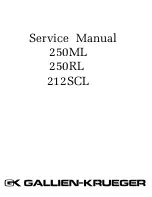
Dear Customer,
The Aleph 1.2 is the most powerful of the newest generation of amplifiers from Pass Labs.
This design results from my commitment to create the best sounding product, a simple circuit
having the most natural characteristic. The Aleph 1.2 integrates power Mosfet devices and
pure single ended Class A operation in a simple two-gain-stage topology with the sole
purpose of recreating subjectively natural sound.
The Aleph 1.2 is unique in a number of ways:
Unlike the early Aleph amplifiers, it operates in pure single-ended mode over its entire
operating region, and does not incorporate a “pull” stage for additional current beyond its bias
point. When the single-ended output Mosfets (two groups of twelve in parallel) reach cutoff,
the amplifier clips.
Most amplifiers on the market have between five and eight gain stages in series between the
input and the output. The Aleph 1.2 has but two, and enjoys a very direct path from input to
output, further enhancing the purity of the circuit and the resulting sound. Early Aleph
amplifiers have three gain stages.
The output stage of the Aleph 1.2 is a unique blend of traditional design and innovation
addressing the unique requirements of loudspeakers. Previous methods of loading the output
stage have used networks consisting of resistors, coils, transformers, and active current
sources, all of which offer an optimal load line based on a resistive load. The Aleph 1.2 has a
current source topology which optimizes performance for a wide range of impedance and
reactance in the load, improving all aspects of performance into real loudspeakers. Pass
Labs has a US patent pending on this output stage topology.
The Aleph 1.2 is unique in that there are no adjustments of any kind in the circuitry. There are
no potentiometers to adjust. The operating parameters of bias currents and DC offset and so
on are defined by physical constants, and will not go out of adjustment.
Most important, the Aleph 1.2 brings a new dimension to the recreation of subjective sonic
reality. The amplifier delivers detail and subjective space rarely found in semiconductor
circuits, coupled with the authority and clarity rarely found in tube amplifiers.
Thank you for purchasing this amplifier. I have personally performed the tests on it, and
guarantee that it meets our production standards. Accompanying is the distortion curve for
this particular amplifier.
This amplifier is different. I have considerable confidence that you will like it, but as the
performance is subjective, you be the judge.
_________________________________
Nelson Pass
Setup





























